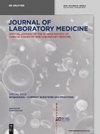Study on pathogen spectrum of 1,046 hospitalized children with respiratory tract infections during COVID-19
IF 1.1
4区 医学
Q4 MEDICAL LABORATORY TECHNOLOGY
引用次数: 0
Abstract
Abstract Objectives This study aimed to describe the pathogen spectrum of bacteria and viruses of RTIs in hospitalized children during the Coronavirus disease 2019 (COVID-19) epidemic in Shenzhen. Methods From October 2020 to October 2021, the results of pathogenic tests causing RTIs were retrospectively analyzed in hospitalized children in Shenzhen Luohu Hospital Group. Results 829 sputum samples for bacterial isolation and 1,037 nasopharyngeal swabs for virus detection in total. The positive detection rate (PDR) of bacteria was 42.1%. Staphylococcus aureus (18.8%) was the predominant bacteria detected in positive cases, with Moraxella catarrhalis (10.9%), Streptococcus pneumoniae (9.5%) following. The PDR of the virus was 65.6%. The viruses ranking first to third were Human Rhinovirus (HRV), Respiratory syncytial virus (RSV), and Human Parainfluenza (HPIV), with rates of 28.0, 18.1, and 13.5%, respectively. Children under 3 years were the most susceptible population to RTIs. The pathogens of S. aureus, M. catarrhalis, S. pneumoniae, HRV, and HPIV were more prevalent in autumn. Meanwhile, RSV had a high rate of infection in summer and autumn. S. aureus and HRV had higher co-infection rates. Conclusions Our findings demonstrate the pathogen spectrum of 1,046 hospitalized children with RTIs in Shenzhen, China, during the COVID-19 outbreak.新冠肺炎期间1046例呼吸道感染住院患儿病原谱分析
摘要目的了解深圳市2019冠状病毒病(COVID-19)流行期间住院儿童呼吸道感染的细菌和病毒病原谱。方法回顾性分析2020年10月至2021年10月深圳罗湖医院集团住院患儿呼吸道感染病原学检查结果。结果共检出829份痰液用于细菌分离,1037份鼻咽拭子用于病毒检测。细菌检出率(PDR)为42.1%。阳性病例检出优势菌为金黄色葡萄球菌(18.8%),其次为卡他莫拉菌(10.9%)、肺炎链球菌(9.5%)。病毒PDR为65.6%。排在前3位的病毒分别是人鼻病毒(HRV)、呼吸道合胞病毒(RSV)和人副流感病毒(HPIV),发病率分别为28.0%、18.1%和13.5%。3岁以下儿童是呼吸道感染的易感人群。秋季以金黄色葡萄球菌、卡他性分枝杆菌、肺炎葡萄球菌、HRV和HPIV为主。夏季和秋季RSV感染率较高。金黄色葡萄球菌和HRV合并感染率较高。结论本研究结果显示了2019冠状病毒病疫情期间深圳1046例呼吸道感染住院儿童的病原体谱。
本文章由计算机程序翻译,如有差异,请以英文原文为准。
求助全文
约1分钟内获得全文
求助全文
来源期刊

Journal of Laboratory Medicine
Mathematics-Discrete Mathematics and Combinatorics
CiteScore
2.50
自引率
0.00%
发文量
39
审稿时长
10 weeks
期刊介绍:
The Journal of Laboratory Medicine (JLM) is a bi-monthly published journal that reports on the latest developments in laboratory medicine. Particular focus is placed on the diagnostic aspects of the clinical laboratory, although technical, regulatory, and educational topics are equally covered. The Journal specializes in the publication of high-standard, competent and timely review articles on clinical, methodological and pathogenic aspects of modern laboratory diagnostics. These reviews are critically reviewed by expert reviewers and JLM’s Associate Editors who are specialists in the various subdisciplines of laboratory medicine. In addition, JLM publishes original research articles, case reports, point/counterpoint articles and letters to the editor, all of which are peer reviewed by at least two experts in the field.
 求助内容:
求助内容: 应助结果提醒方式:
应助结果提醒方式:


